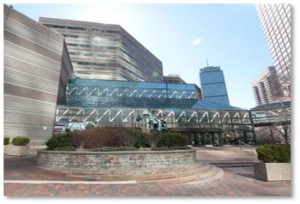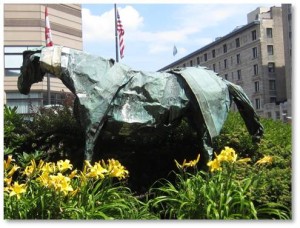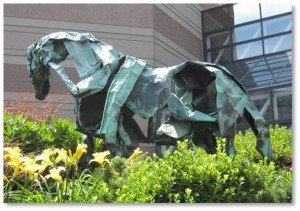Like many other cities, Boston has statues of horses and, like other cities, they mostly serve as mounts for famous men, like George Washington and Paul Revere. But two horses called Paint and Henry graze in a garden outside the Copley Place mall, minus rider or tack. and Henry and they have a history that’s more retail than martial.
Sculpted by Deborah Butterfield, these two “semi-abstract” sculptures are a visual allegory for the establishment of the Neiman Marcus store behind them. They are made of cast bronze from an armature of bronze and copper using the “lost wax” process. Unlike their more heroic counterparts elsewhere in the city, they are not realistic representations of horses or even solid. Here’s the story:
Founding Neiman Marcus
In 1907, Herbert Marcus, Sr. partnered with his sister Carrie M. Neiman and her husband, Abraham L. (Al) Neiman to found a new specialty store in Dallas. Both had retail backgrounds in Dallas’s two leading department stores. Herbert Marcus had been a buyer for Sanger Brothers and Carrie an assistant buyer for A. Harris and Company. Interestingly, the investors passed on an opportunity they called “the sugary soda pop business” now Coca Cola. Although the store opened during an economic recession called the Panic of 1907, it differentiated itself by selling women’s outerwear and millinery that were both high quality and ready to wear—an oxymoron at the time.
The Copley Place Mall, designed by the Architects Collaborative, opened in 1984, and promptly became an upscale shopping area with Neiman Marcus, now known for its luxury goods and outrageous Christmas catalog, as the anchor store. Paint and Henry were installed three years later on the corner of Dartmouth and Stuart Streets.
Sculptor Deborah Butterfield
The sculptor, Deborah Butterfield, is known as a “constructivist” and her horses evoke both the partnership behind the store but also the Texas landscape. Ms. Butterfield has been sculpting horses from a variety of materials, including found wood and metal, since the early 1980s. Her theme was possibly influenced by the fact that she was born on the same day as the 75th running of the Kentucky Derby (Ponder won it.)
Because she only works during winter, each of Ms.Butterfield’s sculptures takes between three and five years to complete. She has received numerous awards, including a National Endowment for the Arts Individual Artist Fellowship, an American Academy of Achievement Award, and a Guggenheim Memorial Fellowship. Ms. Butterfield lives and works in Hawaii and Bozeman, Montana.
Paint and Henry
How you feel about Paint and Henry depends on your opinion of abstract art. Constructivism replaces the historical focus of art on composition with “construction,” which is defined this way by The Art Story:
“Objects were to be created not in order to express beauty, or the artist’s outlook, or to represent the world, but to carry out a fundamental analysis of the materials and forms of art, one which might lead to the design of functional objects. For many Constructivists, this entailed an ethic of “truth to materials,” the belief that materials should be employed only in accordance with their capacities, and in such a way that demonstrated the uses to which they could be put.”
While Paint and Henry are made of cast bronze, they appear to have been cast from armatures of scrap metal that has been twisted into hollow equine shapes. A less kind description would be that they look like they were gift-wrapped at midnight on Christmas Eve by a ham-fisted bachelor uncle.
The two horses face one another across a circular garden in front of the mall’s entrance. Paint stands with head lifted and looking around curiously while Henry looks downward. Although you could not say that either horse has accurate equine anatomy, they convey the stance and attitude of horses — “horsiness: — quite well.
Directions and Information
 Paint and Henry graze at the corner of Stuart Street and Dartmouth Street in front of the Copley Square Mall. They are best seen before the garden around them grows lush and high in the summer. Parking is available in the garage on the other side of Dartmouth Street.
Paint and Henry graze at the corner of Stuart Street and Dartmouth Street in front of the Copley Square Mall. They are best seen before the garden around them grows lush and high in the summer. Parking is available in the garage on the other side of Dartmouth Street.



